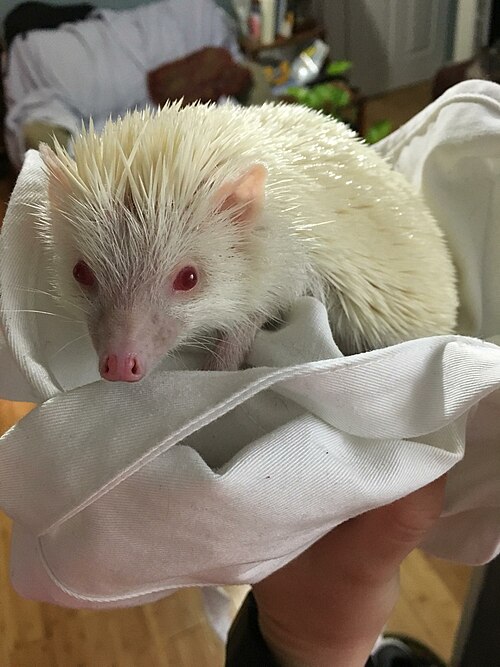Porcupinenoun
Any of several rodents of either of the taxonomic families Hystricidae (Old World porcupines) or Erethizontidae (New World porcupines), both from the infraorder Hystricognathi, noted for their sharp spines or quills, which are raised when the animal is attacked or surprised.
Porcupinenoun
Any Old Word rodent of the genus Hystrix, having the back covered with long, sharp, erectile spines or quills, sometimes a foot long. The common species of Europe and Asia (Hystrix cristata) is the best known.
Porcupinenoun
Any species of Erethizon and related genera, native of America. They are related to the true porcupines, but have shorter spines, and are arboreal in their habits. The Canada porcupine (Erethizon dorsatus) is a well known species.
Porcupinenoun
relatively large rodents with sharp erectile bristles mingled with the fur
Porcupinenoun
a large rodent with defensive spines or quills on the body and tail.
Porcupine
Porcupines are large rodents with coats of sharp spines, or quills, that protect them against predation. The term covers two families of animals: the Old World porcupines of family Hystricidae, and the New World porcupines of family Erethizontidae.
Hedgehognoun
A small mammal, of the family Erinaceidae or subfamily Erinaceinae (pl=s, the latter characterized by their spiny back and often by the habit of rolling up into a ball when attacked.)
Hedgehognoun
(US) Any of several spiny mammals, such as the porcupine, that are similar to the hedgehog.
Hedgehognoun
A type of moveable military barricade made from crossed logs or steel bars, laced with barbed wire, used to damage or impede tanks and vehicles; Czech hedgehog.
Hedgehognoun
A spigot mortar-type of depth charge weapon from World War II that simultaneously fires a number of explosives into the water to create a pattern of underwater explosions intended to attack submerged submarines.
Hedgehognoun
(Australia) A type of chocolate cake (or slice), somewhat similar to an American brownie.
Hedgehognoun
A form of dredging machine.
Hedgehognoun
Certain flowering plants with parts resembling a member of family Erinaceidae
Hedgehognoun
Medicago intertexta, the pods of which are armed with short spines.
Hedgehognoun
Retzia capensis of South Africa.
Hedgehognoun
A kind of electrical transformer with open magnetic circuit, the ends of the iron wire core being turned outward and presenting a bristling appearance.
Hedgehognoun
A way of serving food at a party, consisting of a half melon or potato etc. with individual cocktail sticks of cheese and pineapple stuck into it.
Hedgehogverb
(military) To make use of a hedgehog barricade as a defensive maneuver.
Hedgehogverb
To array with spiky projections like the quills of a hedgehog.
Hedgehogverb
To curl up into a defensive ball.
Hedgehognoun
A small European insectivore (Erinaceus Europæus), and other allied species of Asia and Africa, having the hair on the upper part of its body mixed with prickles or spines. It is able to roll itself into a ball so as to present the spines outwardly in every direction. It is nocturnal in its habits, feeding chiefly upon insects.
Hedgehognoun
The Canadian porcupine.
Hedgehognoun
A species of Medicago (Medicago intertexta), the pods of which are armed with short spines; - popularly so called.
Hedgehognoun
A form of dredging machine.
Hedgehognoun
A variety of transformer with open magnetic circuit, the ends of the iron wire core being turned outward and presenting a bristling appearance, whence the name.
Hedgehognoun
a defensive obstacle having pointed barbs extending outward, such as one composed of crossed logs with barbed wire wound around them, or a tangle of steel beams embedded in concrete used to impede or damage landing craft on a beach; also, a position well-fortified with such defensive obstacles.
Hedgehognoun
relatively large rodents with sharp erectile bristles mingled with the fur
Hedgehognoun
small nocturnal Old World mammal covered with both hair and protective spines
Hedgehog
A hedgehog is a spiny mammal of the subfamily Erinaceinae, in the eulipotyphlan family Erinaceidae. There are seventeen species of hedgehog in five genera found throughout parts of Europe, Asia, and Africa, and in New Zealand by introduction.
























